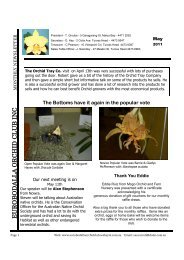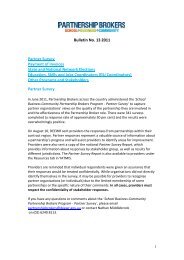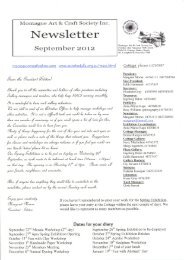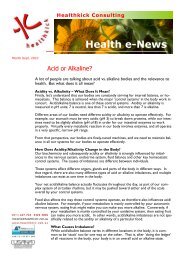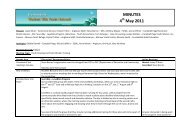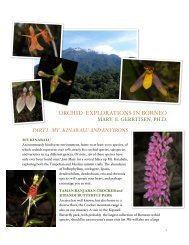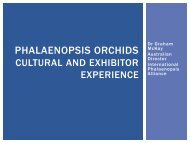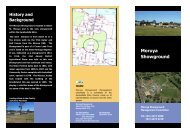Orchid Growing Substrates
Orchid Growing Substrates
Orchid Growing Substrates
Create successful ePaper yourself
Turn your PDF publications into a flip-book with our unique Google optimized e-Paper software.
Important Parameters<br />
With all we listed previously, we can start to work out a potting mix. Now, remains to design what are the<br />
most important parameters :<br />
Pots<br />
- Clay pots will need a bit more water retentive mix.<br />
- Plastic pots will need a less water retentive mix, and more draining one.<br />
- Some growers in the USA use baskets lined with sphagnum moss. They give great results, however on<br />
a commercial scale, that would be somewhat hard to imagine, getting a wood basket, eventually<br />
plastic one, lining it from top to bottom with moss, hanging it and there are other options, so why<br />
bother?<br />
The MAGIC pH.<br />
- There is one pH that suits all the species, except a few exceptions that will be listed afterwards, with a<br />
specific how to pot part 5.7-5.9. There are in fact very few Paphiopedilum species growing at a higher<br />
pH, or the measures were gross mistakes. Paphiopedilum armeniacum grows in fern roots and some<br />
sorts of herb roots, at a quite acid pH of 5.3, however the whole clumps are growing on top of<br />
genuine limestone, with a pH that can be measured at 7.5-8. But the roots never venture in that<br />
alkaline limestone part, they are in the humic/acidic layer. As for Paphiopedilum rothschildianum, I<br />
saw them in the wild some years ago, and again they did not grow in pure rocks or alkaline matters,<br />
but in decayed leaf mould, fern roots, decomposing material, at a pH of about 5.9. True, there was a<br />
lot of serpentine, but for sightseeing only, the rothschildianum roots were always in the humus cover.<br />
- Asking Tony Lamb, who has seen more wild orchids than most people in this world from Sabah, he<br />
said too that in his mind the plants need to be on the slightly acid side, because with all the effluents,<br />
the rain passing through the canopy, decomposing matters and the material that always supported<br />
the roots, he never believed that the Sabah Paphiopedilum needed alkaline conditions. He grew at<br />
Tenom some fantastic clumps of rothschildianum, using leaf mould, tree fern, a few stones (but not<br />
alkaline ones, more a kind of granite), and he did that again now in the Kipandi Butterfly Farm. One<br />
can see as well at the Kundasang dozens of Paphiopedilum rothschildianum, stonei, hookerae,<br />
volonteanum, on the ground, in a blend of leaf mould, debris, and tree fern, with some rocks to<br />
prevent compaction. So much for the ‘alkaline loving’ Paphiopedilum.<br />
- In Burma I saw Paphiopedilum bellatulum, growing in humus, extremely wet. It was hard to see any of<br />
that ‘limestone’ and bellatulum is an acid loving Paphiopedilum, but with calcium carbonate available<br />
at its roots. It seems complicated, but as seen previously, that’s the way to grow it.<br />
- In the Netherlands, the target pH for most commercial potting mixes is 5.7, though some might say<br />
that the Netherlands produce disposable plants. I think that the entire Floricultura motherplant<br />
collections, grown in potting mixes buffered at that pH, is more precious than the entire stock of most<br />
orchid nurseries around the world, yet they use the pot plant potting mixes.<br />
- So our objective, to grow Paphiopedilum will be the pH of 5.7-6.<br />
- Carbonate/lime availability.<br />
Xavier Garreau de Loubresse<br />
32



